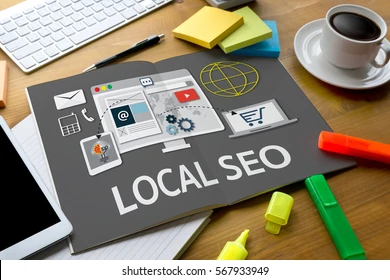For brick-and-mortar businesses, cafés, salons, clinics, or boutiques, the true success metric isn’t website traffic; it’s how many real people walk through the door. While an online presence builds awareness, Local SEO turns that awareness into measurable revenue. In today’s competitive landscape, the ability to connect digital visibility with in-store results has become a defining advantage. With modern analytics and smart optimization tools, businesses can finally track how online searches drive offline sales.
The Connection Between Local SEO and Offline Sales
Local SEO ensures your business appears in searches tied to your area, think “dentist near me” or “restaurant in Bandra.” When potential customers perform such location-based searches, they’re showing clear intent to act. It’s not just about visibility; it’s about being the right business in the right place at the right time.
In this context, According to UnoSearch, a leading SEO intelligence platform, more than 70% of local intent searches result in a physical store visit within 24 hours. The platform emphasizes that consistency, reviews, and updated listings act as digital trust signals that drive customers from screens to storefronts. Businesses that actively optimize their Google Business Profiles and gather authentic reviews see up to 40% higher conversion rates from searches to visits.
This data confirms that local SEO isn’t a vanity metric; it’s a powerful bridge between online engagement and real-world outcomes. When users find accurate information, current photos, and genuine testimonials, they’re far more likely to visit your business in person.
Optimizing for Foot Traffic: Strategies That Work
Your Google Business Profile (GBP) is your digital storefront. It’s the first impression customers get when they find you through maps or local searches. A well-optimized profile, complete with accurate business hours, photos, and service categories, creates credibility and convenience. Each “Get Directions” or “Call Now” action is proof of intent, showing that your listing isn’t just being viewed, it’s driving behavior.
Consistency across all listings is equally vital. Your Name, Address, and Phone (NAP) details must match everywhere Google, Bing, Apple Maps, and local directories. Even small inconsistencies can cause ranking drops or confuse potential customers. Implementing local seo recommendations helps maintain alignment across all platforms and prevent avoidable ranking issues.
Local SEO also thrives on content relevance. Creating neighborhood-targeted pages like “Dental Implants in Bandra West” or “Yoga Studio near Panvel Station” helps you capture hyperlocal searches. Combine this with customer reviews, timely responses, and nearby event mentions to make your brand feel both local and reliable.
Tracking Offline Conversions with Digital Tools
One of the biggest challenges for physical businesses is proving that online visibility leads to in-store visits. Fortunately, digital tools now make this measurable.
Google Business Insights provides data on how users interact with your profile showing search queries, phone calls, and direction requests. Direction requests are often the strongest indicator of a visit since they reflect active interest.
Call tracking systems help you identify which online channels drive phone inquiries. By assigning unique numbers to different marketing sources (like Google Maps or Facebook), you can pinpoint what drives actual customer engagement.
Businesses running ads can use offline conversion tracking on platforms like Google Ads and Meta Ads to import sales data from CRM or POS systems. This helps you connect ad clicks to in-store purchases and measure ROI more effectively.
Additionally, POS and CRM integrations allow you to tag sales by source, whether from a Google listing, an Instagram post, or a website lead. Over time, these insights clarify which digital actions most consistently translate into real visits.
Some advanced setups employ mobile location analytics (MLA), Wi-Fi tracking, or Bluetooth beacons to anonymously monitor visitor flow and dwell time. Though these require more investment and compliance, they provide unmatched accuracy in understanding how customers move through your store and when.
Real-World Example: Local SEO in Action
Consider a boutique in Panvel that revamped its Google Business Profile, built neighborhood-specific landing pages, and encouraged authentic customer reviews. Within three months, direction requests increased by 40%, calls by 30%, and sales data revealed that nearly a quarter of new customers found the boutique online. Wi-Fi analytics confirmed a 20% rise in store visits during promotional weeks.
By syncing its data with UnoSearch’s analytics tools, the boutique identified clear correlations between online visibility and in-store conversions. This allowed them to focus their SEO efforts on keywords, content, and listings that directly influenced foot traffic.
Challenges and Best Practices
Tracking offline conversions isn’t without challenges. Privacy compliance must always come first—customers should know how data is being used, especially with Wi-Fi or beacon tracking. Attribution can also be complex, as not every visit leaves a digital trace.
The key is to analyze trends over time, not isolated metrics. Combining multiple data sources Google Insights, CRM data, and call tracking creates a more accurate view of offline success. According to UnoSearch’s local performance framework, businesses that diversify their tracking approach achieve a 25–30% higher accuracy in understanding their offline conversions.
Conclusion
Local SEO has evolved from a simple ranking tactic into a measurable growth engine. It’s no longer about just being visible; it’s about being reachable, relevant, and trusted. When optimized correctly, local SEO doesn’t just bring traffic to your website; it brings people through your door.
Platforms like UnoSearch are leading this transformation by helping businesses understand how their digital actions shape real-world outcomes. By combining Google Business optimization, consistent listings, insightful analytics, and ethical data tracking, businesses can confidently turn clicks into customers.
In the modern marketplace, success belongs to those who connect the digital journey with the physical experience. With tools like UnoSearch guiding your strategy, you can ensure that every search, every click, and every direction request translates into measurable, lasting growth.






